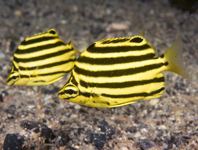Abstract
We redescribe the triacanthodid spikefish Mephisto fraserbrunneri Tyler 1966 based upon eight specimens (five newly reported herein) and the first color photographs of freshly collected specimens; these data are compared with that of the single specimen of the recently described M. albomaculosus Matsuura, Psomadakis, and Mya Than Tun 2018. Both species are found in the Indian Ocean, with M. fraserbrunneri known from the Arabian Sea off the east coast of Africa to the eastern Bay of Bengal, and M. albomaculosus confirmed only from the type locality in the Andaman Sea (a color photograph of an individual M. cf. albomaculosus from the Bay of Bengal that was not retained is also presented). We describe and diagnose the genus Mephisto and provide a key to the two species based upon all available specimens. We also provide a distribution map for both species and summarize literature records. Using micro-CT data, we show that Mephisto fraserbrunneri replaces teeth intraosseously, which suggests this tooth replacement pattern is plesiomorphic for Tetraodontiformes.
References
Aboussouan, A. & Leis, J.M. (1984) Balistoidei: Development. In H.G. Moser, W.J. Richards, D.M. Cohen, M.P. Fahay, A.W. Kendall and S.L. Richardson (Eds.), Ontogeny and Systematics of Fishes. American Society of Ichthyologists and Herpetologists Special Publication No 1. Allen Press, Lawrence, Kansas, pp. 450–459.
Arcila, D. & Tyler, J.C. (2017) Mass extinction in tetraodontiform fishes linked to the Palaeocene—Eocene thermal maximum. Proceedings of the Royal Society B, 284, 20171771.
https://doi.org/10.1098/rspb.2017.1771
Bemis, K.E., Tyler, J.C. & Arcila, D. (2019) Life history, distribution, and molecular phylogenetics of the Upward-Mouth Spikefish Atrophacanthus japonicus (Teleostei: Tetraodontiformes: Triacanthodidae). Journal of Fish Biology, 94, 578–584.
https://doi.org/10.1111/jfb.13923
Bemis, K.E., Tyler, J.C., Bemis, W.E., Kishor, K., Rana, R.S. & Smith, T. (2017) A gymnodont fish jaw with remarkable molariform teeth from the early Eocene of Gujarat, India (Teleostei, Tetraodontiformes). Journal of Vertebrate Paleontology, 37, 1–10.
https://doi.org/10.1080/02724634.2017.1369422
Ferris, L.N. (2019) ocean_data_tools: Scripts for writing bulk freely-available oceanographic data into data structures and making plots.
https://doi.org/10.5281/zenodo.3353610. (accessed 20 January 2020)
Gorelova, T.A., Borodulina, O.D., Vereshchaka, A.L. & Shcherbachev, Y.N. (1993) Data on feeding of some mesobenthic and bathybenthic fishes in the Indian Ocean. Trudy Instituta Oceanologii, 128, 217–230. [in Russian with English summary]
Locarnini, R.A., Mishonov, A.V., Baranova, O.K., Boyer, T.P., Zweng, M.M., Garcia, H.E., Reagan, J.R., Seidov, D., Weathers, K., Paver, C.R. & Smolyar, I. (2018) World Ocean Atlas 2018. Vol. 1. Temperature. In: Mishonov, A. (Technical Ed.), NOAA Atlas NESDIS, 81, pp. 1–52.
Manilo, I.G. & Bogorodsky, S.V. (2003) Taxonomic composition, diversity and distribution of coastal fishes of the Arabian Sea. Journal of Ichthyology, 43, S75–S149.
Matsuura, K. (2015) Taxonomy and systematics of tetraodontiform fishes: A review focusing primarily on progress in the period from 1980 to 2014. Ichthyological Research, 62, 72–113.
https://doi.org/10.1007/s10228-014-0444-5
Matsuura, K., Psomadakis, P. & Tun, M.T. (2018) Mephisto albomaculosus, a new spikefish (Actinopterygii: Tetraodontiformes: Triacanthodidae) collected off Myanmar, Indian Ocean. Ichthyological Research, 66, 30–33.
https://doi.org/10.1007/s10228-018-0642-7
Mullasseri, S., Korath, A., Vidyan, V., Fricke, R., Suresh, A. & Chanran, H. (2017) First record of Paratriacanthodes retrospinis Fowler, 1934 (Tetraodontiformes: Triacanthodidae) from the Andaman Islands, northeastern Indian Ocean. FishTaxa, 2 (2), 76–81.
Rosset, A., Spadola, L. & Ratib, O. (2004) OsiriX: An open-source software for navigating in multidimensional DICOM images. Journal of Digital Imaging, 17, 205–216.
https://doi.org/10.1007/s10278-004-1014-6
Sabaj, M.H. (2019) Standard symbolic codes for institutional resource collections in herpetology and ichthyology: An online reference. Version 7.1. American Society of Ichthyologists and Herpetologists, Washington, D.C. Available from: http://www.asih.org/ (accessed 20 March 2019)
Santini, F. & Tyler, J.C. (2003) A phylogeny of the families of fossil and extant tetraodontiform fishes (Acanthomorpha, Tetraodontiformes), Upper Cretaceous to Recent. Zoological Journal of the Linnean Society, 139, 565–617.
https://doi.org/10.1111/j.1096-3642.2003.00088.x
Shcherbachev, Y.N., Parin, N.V., Pakhorukov, N.P. & Piotrovsky, A.S. (1986) Mesobenthic and mesobenthopelagic fishes from submarine rises in the western Indian Ocean. Trudy Instituta Okeanologii, 121, 195–214. [in Russian with English summary]
Smith, W.H.F. & Sandwell, D.T. (1997) Global seafloor topography from satellite altimetry and ship depth soundings. Science, 277, 1957–1962.
https://doi.org/10.1126/science.277.5334.1956
Trapani, J. (2001) Position of developing replacement teeth in teleosts. Copeia, 2001 (1), 35–51.
https://doi.org/10.1643/0045-8511(2001)001[0035:PODRTI]2.0.CO;2
Tyler, J.C. (1966a) A new genus and species of triacanthodid fish (Plectognathi) from the Indian Ocean. Academy of Natural Sciences of Philadelphia, Notulae Naturae, 385, 1–5.
Tyler, J.C. (1966b) Bathyphylax omen, a new species of triacanthodid plectognath fish from the Indian Ocean. Academy of Natural Sciences of Philadelphia, Notulae Naturae, 395, 1–5.
Tyler, J.C. (1968) A monograph on plectognath fishes of the Superfamily Triacanthoidea. Academy of Natural Sciences of Philadelphia, Monograph 16, 1–364.
Tyler, J.C. (1980) Osteology, phylogeny, and higher classification of the fishes of the Order Plectognathi (Tetraodontiformes). NOAA Technical Report, NMFS Circular, 434, 1–422.
https://doi.org/10.5962/bhl.title.63022
Tyler, J. C. (1986) Family No. 265: Triacanthodidae, Spikefishes, Spykervisse. In: Smith, M.M. & Heemstra, P.C. (Eds.), Smith’s Sea Fishes. Smith Institute of Ichthyology, Macmilliam, pp. 887–890.
Tyler, J.C., Jerzmanska, A., Bannikov, A.F. & Swidnicki, J. (1993) Two new genera and species of Oligocene spikefishes (Tetraodontiformes: Triacanthodidae), the first fossils of the Hollardiinae and Triacanthodinae. Smithsonian Contributions to Paleobiology, 75, 1–27.
https://doi.org/10.5479/si.00810266.75.1
Zweng, M.M., Reagan, J.R., Seidov, D., Boyer, T.P., Locarnini, R.A., Garcia, H.E., Mishonov, A.V., Baranova, O.K., Weathers, K., Paver, C.R. & Smolyar, I. (2018) World Ocean Atlas 2018. Vol. 2. Salinity. In: Mishonov, A. (Technical Ed.), NOAA Atlas NESDIS, 82, pp. 1–50.


